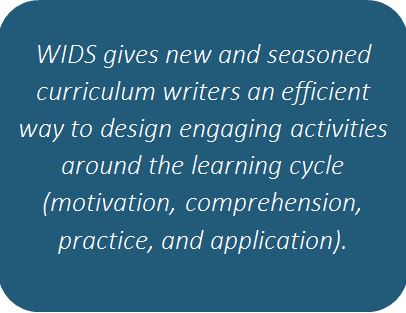Instructional Alignment Theory
Excerpt from the 2008 white paper - WIDS History
WIDS software provides a framework where learning outcomes and assessments can be identified, connected, and shared -- a physical "alignment" of instructional design. This instructional alignment idea, supported by decades of research, involves "congruence between stimulus conditions of instruction and stimulus conditions of assessment" (Cohen, 1987). It assumes there is purposeful connection between assessment and instruction. Cohen found this alignment to consistently generate large effects, "which is probably why the idea of instructional alignment is so well-entrenched in the conventional wisdom of instructional designers" (Cohen, 1987).
Recent research builds on Cohen's findings, and provides "strong evidence from scientifically based research that aligning various components can have positive and significant effects" (Edvantia, 2005). WIDS incorporates these ideas and helps educators think about links between:
- Competencies and assessment
- Competencies and instructional activities and materials
- Assessments and instructional activities and materials
Instructional alignment empowers educators to examine and enhance their curriculum and to learn of their intentions when analyzing instructional activities. The software becomes the vehicle for asking: "What's worth teaching" or "What's worth assessing?"
 WIDS software supports instructional alignment theory. It provides for development of both technical and academic skills, and it provides a platform around which the two can mesh. Going beyond low-level objectives, WIDS gives educators the tool to develop performance standards, learning objectives, and assessments -- showing how they fit together for the learner. Effective learning activities stated in a Learning Plan motivate learners, allow for comprehension and practice, and encourage application of knowledge.
WIDS software supports instructional alignment theory. It provides for development of both technical and academic skills, and it provides a platform around which the two can mesh. Going beyond low-level objectives, WIDS gives educators the tool to develop performance standards, learning objectives, and assessments -- showing how they fit together for the learner. Effective learning activities stated in a Learning Plan motivate learners, allow for comprehension and practice, and encourage application of knowledge.
The Learning Activity Library is available to software users as they consider ways to improve their learning activities and transfer student learning to work or life role applications.
Just as new technologies are used by students, instructors have new technologies for curriculum design. Any tool or strategy that can help streamline data, information, and documentation is in demand-by both instructors and managers. Because WIDS is a relational database, once initial course and program design is complete, the ability to access that information and display it in a variety of ways-to a variety of audiences-is easy to do. Instructors faced with an accreditation visit, for example, use WIDS data to produce documentation for learners and documentation required for accreditation.
Read more about the WIDS Model and History in the 2008 paper WIDS History.
8353